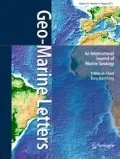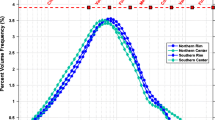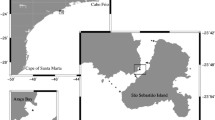Abstract
Field observations of current profiles and temperature, salinity, and density structure were used to examine vertical mixing within two pockmarks in Belfast Bay, Maine. The first is located in 21 m water depth (sea level to rim), nearly circular in shape with a 45 m rim diameter and 12 m rim-to-bottom relief. The second is located in 25 m water depth, more elongated in shape with an approximately 80 m (36 m) major (minor) axis length at the rim, and 17 m relief. Hourly averaged current profiles were acquired from bottom-mounted acoustic Doppler current profilers deployed on the rim and center of each pockmark over successive 42 h periods in July 2011. Conductivity–temperature–depth casts at the rim and center of each pockmark show warmer, fresher water in the upper water column, evidence of both active and fossil thermocline structure 5–8 m above the rim, and well-mixed water below the rim to the bottom. Vertical velocities show up- and down-welling events that extend into the depths of each pockmark. An observed temperature change at both the rim and center occurs coincident with an overturning event below the rim, and suggests active mixing of the water column into the depths of each pockmark. Vertical profiles of horizontal velocities show depth variation at both the center and rim consistent with turbulent logarithmic current boundary layers, and suggest that form drag may possibly be influencing the local flow regime. While resource limitations prevented observation of the current structure and water properties at a control site, the acquired data suggest that active mixing and overturning within the sampled pockmarks occur under typical benign conditions, and that current flows are influenced by upstream bathymetric irregularities induced by distant pockmarks.












Similar content being viewed by others
References
Andrews BD, Brothers LL, Barnhardt WA (2010) Automated feature extraction and spatial organization of seafloor pockmarks, Belfast Bay, Maine, USA. Geomorphology 124:55–64
Arya SPS (1975) A drag partition theory for determining the large-scale roughness parameter and wind stress on the arctic pack ice. J Geophys Res 80:3447–3454
Brothers LL, Kelley JT, Belknap DF, Barnhardt WA, Andrews BD, Maynard ML (2011a) More than a century of bathymetric observations and present-day shallow sediment characterization in Belfast Bay, Maine, USA: implications for pockmark field longevity. Geo-Mar Lett 31:237–248
Brothers LL, Kelley JT, Belknap DF, Barnhardt WA, Koons PO (2011b) Pockmarks: self-scouring seep features? In: Proc 7th Int Conf Gas Hydrates, 17–21 July, Edinburgh, UK
Brothers LL, Kelley JT, Belknap DF, Barnhardt WA, Andrews BD, Legere C, Hughes Clarke JE (2012) Shallow stratigraphic control on pockmark distribution in north temperate estuaries. Mar Geol 329–331:34–45
Chelton DB (1983) Effects of sampling errors in statistical estimation. Deep Sea Res 30:1083–1103
Chriss TM, Caldwell DR (1982) Evidence for the influence of form drag on bottom boundary layer flow. J Geophys Res 87:4148–4154
Christodoulou D, Papatheodorou G, Ferentinos G, Masson M (2003) Active seepage in two contrasting pockmark fields in the Patras and Corinth Gulfs, Greece. Geo-Mar Lett 23:194–199
Fandel CL, Lippmann TC, Foster DL, Brothers LL (2016a) Observations of pockmark flow structure in Belfast Bay, Maine, Part 2: evidence for cavity flow. Geo-Mar Lett, this volume. doi:10.1007/s00367-016-0473-3
Fandel CL, Lippmann TC, Foster DL, Brothers LL (2016b) Observations of pockmark flow structure in Belfast Bay, Maine, Part 3: implications for sediment transport. Geo-Mar Lett, this volume. doi:10.1007/s00367-016-0474-2
Gay A, Lopez M, Ondreas H, Charlou JL, Sermondadaz G, Cochonat P (2005) Seafloor facies related to upward methane flux within a giant pockmark of the lower Congo Basin. Mar Geol 226:81–95
Hammer Ø, Webb KE, Depreiter D (2009) Numerical simulation of upwelling currents in pockmarks, and data from the Inner Oslofjord, Norway. Geo-Mar Lett 29:269–275
Hovland M, Judd A (1988) Seabed pockmarks and seepages: impact on geology, biology, and the marine environment. Graham and Trotman, London
Hovland M, Svensen H (2006) Submarine pingoes: indicators of shallow gas hydrates in a pockmark at Nyegga, Norwegian Sea. Mar Geol 228:15–23
Hovland M, Svensen H, Forsberg CF, Johansen H, Fichler C, Fosså JH, Jonsson R, Rueslåtten H (2005) Complex pockmarks with carbonate-ridges off mid-Norway: products of sediment degassing. Mar Geol 218:191–206
Kelley JT, Dickson SM, Belknap DF, Barnhardt WA, Henderson M (1994) Giant sea-bed pockmarks: evidence for gas escape from Belfast Bay. Geology 22:59–62
Kilhams B, McArthur A, Huuse B, Ita E, Hartley A (2011) Enigmatic large-scale furrows of Miocene to Pliocene age from the central North Sea: current-scoured pockmarks? Geo-Mar Lett 31:437–449
Manley PL, Manley TO, Watzin MC, Gutierrez J (2004) Lakebed pockmarks in Burlington Bay, Lake Champlain: I. Hydrodynamics and implications of origin. In: Manley TO, Manley PL, Mihuc TB (eds) Lake Champlain: partnerships and research in the new millennium. Springer, Berlin, pp 299–330
McCabe RM, MacCready P, Pawlak G (2006) Form drag due to flow separation at a headland. J Phys Oceanogr 36:2136–2152
Pau M, Hammer O (2013) Sediment mapping and long-term monitoring of currents and sediment fluxes in pockmarks in the Oslofjord, Norway. Mar Geol 346:262–273
Pau M, Gisler G, Hammer Ø (2014) Experimental investigation of the hydrodynamics in pockmarks using particle tracking velocimetry. Geo-Mar Lett 34:11–19
RD Instruments (2005) Workhorse acoustic Doppler current profiler technical manual. RD Instruments P/N957-6150-00, pp 196
Ritt B, Pierre C, Gauthier O, Wenzhöfer F, Boetius A, Sarrazin J (2011) Diversity and distribution of cold-seep fauna associated with different geological and environmental settings at mud volcanoes and pockmarks of the Nile Deep-Sea Fan. Mar Biol 158:1187–1210
Rogers JN, Kelley JT, Belknap DF, Gontz A, Barnhardt WA (2006) Shallow-water pockmark formation in temperate estuaries: a consideration of origins in the western gulf of Maine with special focus on Belfast Bay. Mar Geol 225:45–62
Scanlon KM, Knebel HJ (1989) Pockmarks in the floor of Penobscot Bay, Maine. Geo-Mar Lett 9:53–58
Tennekes H, Lumley JL (1972) A first course in turbulence. IBM Univ Medium, USA
US Geological Survey (2010) Stream gauge data. http://waterdata.usgs.gov/me/nwis
Weather Underground, Inc. (2011) http://www.wunderground.com
Wildish DJ, Akagi HM, McKeown DL, Pohle GW (2008) Pockmarks influence benthic communities in Passamaquoddy Bay, Bay of Fundy, Canada. Mar Ecol Prog Series 357:51–66
Xue H, Brooks D (2000) Characterization of fronts and eddies in Penobscot Bay using a three-dimensional ocean circulation model. Final Report presented to Island Institute, Rockland, ME
Xue H, Xu Y, Brooks H, Pettigrew N, Wallinga J (2000) Modeling the circulation in Penobscot Bay, Maine. Estuarine and Coastal Modeling. In: Proc 6th Int Conf, American Society of Engineers, New Orleans, LA
Acknowledgements
Data collected as part of this study are available at the Center for Coastal and Ocean Mapping, University of New Hampshire under the experiment name “2011 Belfast Bay Pockmark Experiment”. J. Kelley of the University of Maine provided the multibeam bathymetry map from which candidate pockmarks were identified for further consideration. This study was based on a model conceived and developed by P. Koons of the University of Maine, and the many observations and interpretations made by J. Kelley, D. Bleknap (University of Maine), W. Barnhardt (USGS), and B. Andrews (USGS). Field assistance was provided by Capt. Emily Terry, Capt. Ben Smith, and Jon Hunt. Comments by Diane Foster, Zafere Defne, Ø. Hammer, and an anonymous reviewer greatly improved the manuscript. This study was supported by the National Oceanic and Atmospheric Administration under NOAA grant NA10NOS4000073. Any use of trade, firm, or product names is for descriptive purposes only and does not imply endorsement by the US Government.
Author information
Authors and Affiliations
Corresponding author
Ethics declarations
Conflict of interest
The authors declare that there is no conflict of interest with third parties.
Rights and permissions
About this article
Cite this article
Fandel, C.L., Lippmann, T.C., Irish, J.D. et al. Observations of pockmark flow structure in Belfast Bay, Maine, Part 1: current-induced mixing. Geo-Mar Lett 37, 1–14 (2017). https://doi.org/10.1007/s00367-016-0472-4
Received:
Accepted:
Published:
Issue Date:
DOI: https://doi.org/10.1007/s00367-016-0472-4




